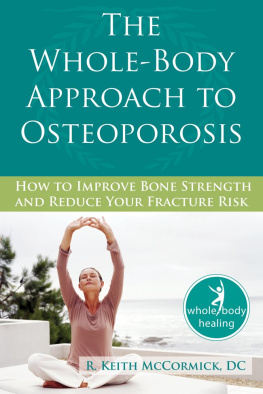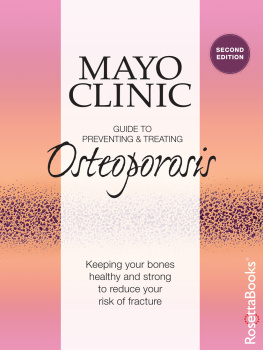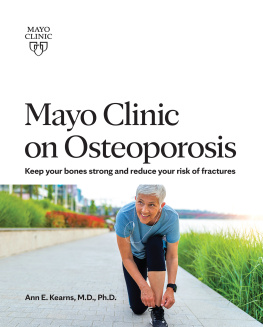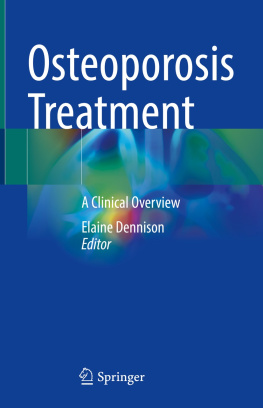R. McCormick - The Whole-Body Approach to Osteoporosis: How to Improve Bone Strength and Reduce Your Fracture Risk
Here you can read online R. McCormick - The Whole-Body Approach to Osteoporosis: How to Improve Bone Strength and Reduce Your Fracture Risk full text of the book (entire story) in english for free. Download pdf and epub, get meaning, cover and reviews about this ebook. year: 2009, publisher: New Harbinger Publications, genre: Children. Description of the work, (preface) as well as reviews are available. Best literature library LitArk.com created for fans of good reading and offers a wide selection of genres:
Romance novel
Science fiction
Adventure
Detective
Science
History
Home and family
Prose
Art
Politics
Computer
Non-fiction
Religion
Business
Children
Humor
Choose a favorite category and find really read worthwhile books. Enjoy immersion in the world of imagination, feel the emotions of the characters or learn something new for yourself, make an fascinating discovery.
- Book:The Whole-Body Approach to Osteoporosis: How to Improve Bone Strength and Reduce Your Fracture Risk
- Author:
- Publisher:New Harbinger Publications
- Genre:
- Year:2009
- Rating:5 / 5
- Favourites:Add to favourites
- Your mark:
- 100
- 1
- 2
- 3
- 4
- 5
The Whole-Body Approach to Osteoporosis: How to Improve Bone Strength and Reduce Your Fracture Risk: summary, description and annotation
We offer to read an annotation, description, summary or preface (depends on what the author of the book "The Whole-Body Approach to Osteoporosis: How to Improve Bone Strength and Reduce Your Fracture Risk" wrote himself). If you haven't found the necessary information about the book — write in the comments, we will try to find it.
R. McCormick: author's other books
Who wrote The Whole-Body Approach to Osteoporosis: How to Improve Bone Strength and Reduce Your Fracture Risk? Find out the surname, the name of the author of the book and a list of all author's works by series.
The Whole-Body Approach to Osteoporosis: How to Improve Bone Strength and Reduce Your Fracture Risk — read online for free the complete book (whole text) full work
Below is the text of the book, divided by pages. System saving the place of the last page read, allows you to conveniently read the book "The Whole-Body Approach to Osteoporosis: How to Improve Bone Strength and Reduce Your Fracture Risk" online for free, without having to search again every time where you left off. Put a bookmark, and you can go to the page where you finished reading at any time.
Font size:
Interval:
Bookmark:
Acknowledgments
There are four special people from New Harbinger Publications whom I would like to acknowledge. The idea for this book would not have been born without Wendy Millstine, acquistions editor. I am indebted to Wendy for her unwavering belief in me. Thank you to Kayla Sussell, whose expertise and painstaking copy editing efforts helped bring the book to full fruition. A heartfelt thank-you to Jasmine Star, proofreader extraordinaire, and to Heather Mitchener, editorial director, for contributing so much to this books readability.
This book would not have been possible without the constant encouragement, endless late nights of dedication, and fine attention to concept and detail of my local editor, Elizabeth Earl Phillips. Thank you, Liz.
Many thanks go to my patients who have inspired my studies of bone biology and osteoporosis and especially to those who have personally encouraged me over the past year during the writing of this book. And thank you to Christine Purcell, my office manager, for putting up with my constant writing and inattention to business matters.
I would like to extend a very special thank-you to Mary Ann Page and John Clayton, who so graciously offered to read this manuscript and suggest organizational and editorial changes.
Thank you to Paul Rezendes for his teachings and deep friendship, and to his wife Paulette Roy for her help and support when I was in the first stages of preparing to undertake this project.
I extend my sincerest appreciation to Christy Maxwell, MS; Eve Bralley, Ph.D.; Jeffery Moss, DDS; Tom OBryan, DC; and Ted Czepiel, DC; for their literary research and professional suggestions. Thank you also to Nancy Haver for your wonderful illustrations.
Special thanks go to my good friend, Kara Fitzgerald, ND, for her generosity with time and her invariable willingness to discuss complex scientific issues. Karas brilliance brought substantial depth to this book.
And, finally, I would like to express profound thanks to my wife, Eva Lohrer, for her patience around the hours and hours of time I needed to complete this book and to my two sons, Ty for his encouragement and Colten for the endless games of floor hockey that kept me sane.
Appendix
Calcium. This mineral is vital for skeletal mineralization, blood clotting, conduction of nerve impulses, buffering of acidic blood, enzyme activity, and muscle contractions.
- Deficiency signs and symptoms: Bone loss, periodontal disease, tooth decay, and muscle spasms.
- BiomarkersComprehensive metabolic panel (CMP): The level of calcium in your blood can be obtained through a CMP. If elevated, it may indicate an overactive parathyroid gland or a malignancy. If low, it may indicate that you are not getting enough calcium or that you have a malabsorption problem, a magnesium deficiency, or an insufficient secretion of the parathyroid hormone (PTH) from your parathyroid glands. Hair: Interpretation of calcium status is difficult with hair analysis, but early detection of low bone density caused by endocrine disease (hyperparathyroidism or hyperthyroidism) can be seen when there is a significant increase in the calcium level of hair (Miekeley et al. 2001).
- Laboratory correlatesVitamin D [25(OH)D]: If your calcium is low, it may mean insufficient vitamin D. Magnesium: Low blood calcium can be due to a deficiency of magnesium. Albumin: Low albumin levels may be due to low blood calcium levels or to overall poor nutrition. Celiac profile: Low calcium can indicate the malabsorption of celiac disease. Anemia: If low calcium and anemia are found, it is important to test for celiac disease.
- Dietary sources: Dairy products, figs, vegetables (especially kale, broccoli, bok choy, collards, mustard greens, and turnip greens), sea vegetables, bean sprouts, spinach, teff (a nongluten grain), nuts, seeds, beans, and tofu.
- Supplementation: Microcrystalline hydroxyapatite complex, calcium citrate, or calcium citrate/malate are the best sources for supplemental calcium. Adult daily intake should be 1,200 to 1,500 mg/day. Your calcium to phosphorus dietary ratio should be 1:1 and not exceed 2:1.
Phosphorus. This mineral is important for energy, enzyme activity, muscle contraction, and nerve contractions.
- Deficiencysigns andsymptoms: Malnutrition.
- Biomarkers:CMP. If elevated, it may indicate kidney disease or genetic disorders. Elevated phosphorus may also be seen with bisphosphonate use. If low, it may indicate malabsorption, hyperparathyroid, or genetic disorders.
- Laboratory correlatesVitamin D: Low phosphorus may indicate vitamin D insufficiency. Calcium: Blood calcium levels will be affected by fluctuations in blood phosphorus. PTH: Abnormal phosphorus levels can mean a parathyroid gland disorder.
- Dietary sources: Most foods, especially dairy, cereals, eggs, and meat.
- Supplementation: Phosphorus is abundant in most foods and usually unnecessary to supplement. In fact, the Western diet is often too high in acid-producing phosphorus. Keep your dietary ratio of phosphorus to calcium at 1:1. High-phosphorus diets lead to metabolic acidosis and calcium loss.
Magnesium. This is one of the most important nutrients in your body. It is vital for cell energy metabolism, nerve conduction, cell membrane integrity, electrolyte balance, and the proper functioning of over three hundred enzymes. Deficiency reduces osteoblast bone formation and increases osteoclast bone resorption. Magnesium is necessary for release of the hormone calcitonin from the thyroid gland, and for the production of parathyroid hormone. Both hormones are necessary for bone health.
- Deficiency signs and symptoms: Muscle spasms, skin twitching below the eye, constipation, hypertension, rapid heart rate, arrhythmias, depression, fatigue, asthma, muscle weakness, irritability, and hypersensitive skin.
- Biomarkers:Red blood cell (RBC) magnesium. Only whole-blood magnesium levels accurately reflect total body levels. Serum magnesium is not a good indicator of total body level.
- Laboratory correlatesCalcium (blood): Inadequate magnesium may cause low serum calcium. Potassium: Low serum potassium can correlate to low magnesium levels. Vitamin D (active vitamin D [1,25(OH)2D]: This form of vitamin D may be low when total magnesium levels are inadequate.Anemia: Low magnesium can lead to anemia (seen on CBC).PTH: Low magnesium levels can elevate parathyroid hormone levels. Osteocalcin (bone formation marker): Inadequate bone formation, as reflected by low osteocalcin, may be a consequence of inadequate magnesium. Hs-CRP (C-reactive protein): Low magnesium can increases the pro-inflammatory cytokines (IL-6 and TNF) and would be reflected as elevated levels of hs-CRP.
- Dietary sources: Legumes, whole grains, broccoli, green leafy vegetables, animal protein, seeds (especially pumpkin), nuts, and, yes, chocolate.
- Supplementation: 600 to 750 mg/day may be optimal for osteoporosis. Keep your calcium to magnesium intake ratio balanced at approximately 2:1. Use magnesium ascorbate, aspartate, gluconate, or malate. Avoid magnesium oxide and carbonate. Note that excess magnesium can give you loose stools.
Zinc.
Next pageFont size:
Interval:
Bookmark:
Similar books «The Whole-Body Approach to Osteoporosis: How to Improve Bone Strength and Reduce Your Fracture Risk»
Look at similar books to The Whole-Body Approach to Osteoporosis: How to Improve Bone Strength and Reduce Your Fracture Risk. We have selected literature similar in name and meaning in the hope of providing readers with more options to find new, interesting, not yet read works.
Discussion, reviews of the book The Whole-Body Approach to Osteoporosis: How to Improve Bone Strength and Reduce Your Fracture Risk and just readers' own opinions. Leave your comments, write what you think about the work, its meaning or the main characters. Specify what exactly you liked and what you didn't like, and why you think so.






